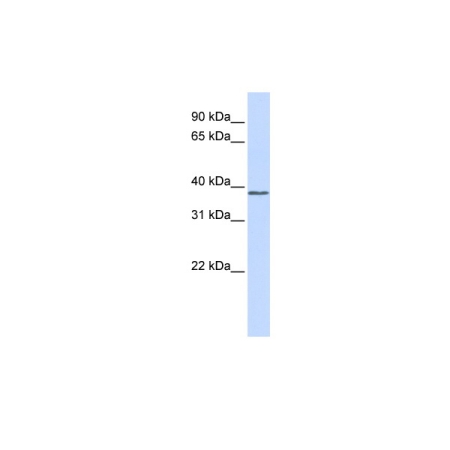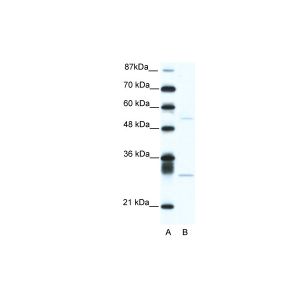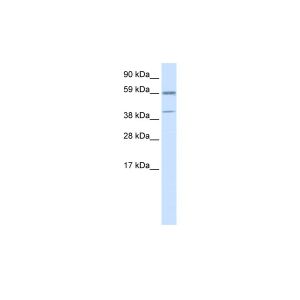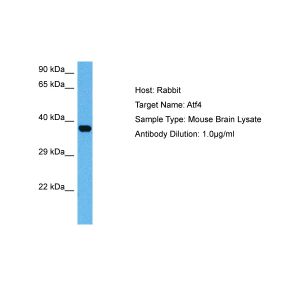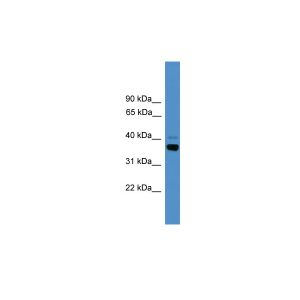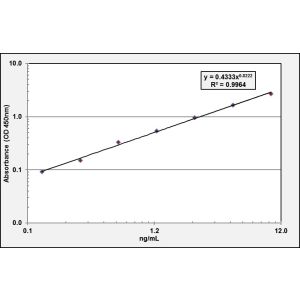ATF4 Antibody - middle region : FITC
Cat# P100913_P050-FITC
Size : 100ul
Marca : Aviva Systems Biology
| Datasheets/Manuals | Printable datasheet for anti-ATF4 (P100913_P050) antibody |
|---|
| Tested Species Reactivity | Human |
|---|---|
| Predicted Species Reactivity | Human, Mouse, Rat, Dog, Pig |
| Product Format | Liquid. Purified antibody supplied in 1x PBS buffer with 0.09% (w/v) sodium azide and 2% sucrose. |
| Clonality | Polyclonal |
| Host | Rabbit |
| Application | WB |
| Reconstitution and Storage | For short term use, store at 2-8C up to 1 week. For long term storage, store at -20C in small aliquots to prevent freeze-thaw cycles. |
| Immunogen | The immunogen is a synthetic peptide directed towards the middle region of human ATF4 |
| Purification | Affinity Purified |
| Predicted Homology Based on Immunogen Sequence | Dog: 78%; Human: 100%; Mouse: 90%; Pig: 81%; Rat: 90% |
| Peptide Sequence | Synthetic peptide located within the following region: LGSEVDITEGDRKPDYTAYVAMIPQCIKEEDTPSDNDSGICMSPESYLGS |
| Concentration | 0.5 mg/ml |
| Blocking Peptide | For anti-ATF4 (P100913_P050) antibody is Catalog # AAP31265 (Previous Catalog # AAPP02014) |
| Reference | Zhou,D., (2008) J. Biol. Chem. 283 (11), 7064-7073 |
|---|---|
| Gene Symbol | ATF4 |
| Gene Full Name | Activating transcription factor 4 (tax-responsive enhancer element B67) |
| Alias Symbols | CREB2, TXREB, CREB-2, TAXREB67 |
| NCBI Gene Id | 468 |
| Protein Name | Cyclic AMP-dependent transcription factor ATF-4 |
| Description of Target | ATF4s a transcription factor that was originally identified as a widely expressed mammalian DNA binding protein that could bind a tax-responsive enhancer element in the LTR of HTLV-1. The encoded protein was also isolated and characterized as the cAMP-response element binding protein 2 (CREB-2). The protein encoded by this gene belongs to a family of DNA-binding proteins that includes the AP-1 family of transcription factors, cAMP-response element binding proteins (CREBs) and CREB-like proteins. These transcription factors share a leucine zipper region that is involved in protein-protein interactions, located C-terminal to a stretch of basic amino acids that functions as a DNA binding domain. Two alternative transcripts encoding the same protein have been described. Two pseudogenes are located on the X chromsome at q28 in a region containing a large inverted duplication.This gene encodes a transcription factor that was originally identified as a widely expressed mammalian DNA binding protein that could bind a tax-responsive enhancer element in the LTR of HTLV-1. The encoded protein was also isolated and characterized as the cAMP-response element binding protein 2 (CREB-2). The protein encoded by this gene belongs to a family of DNA-binding proteins that includes the AP-1 family of transcription factors, cAMP-response element binding proteins (CREBs) and CREB-like proteins. These transcription factors share a leucine zipper region that is involved in protein-protein interactions, located C-terminal to a stretch of basic amino acids that functions as a DNA binding domain. Two alternative transcripts encoding the same protein have been described. Two pseudogenes are located on the X chromsome at q28 in a region containing a large inverted duplication. |
| Uniprot ID | P18848 |
| Protein Accession # | NP_001666 |
| Nucleotide Accession # | NM_001675 |
| Protein Size (# AA) | 351 |
| Molecular Weight | 38kDa |
| Protein Interactions | GPS2; GOLGA1; EP300; CEBPG; GOLGA8F; GOLGA8EP; GCC1; TRIB3; CCDC106; LDOC1; FBXW11; NDC80; BTRC; BFSP2; DDIT3; CREBBP; NEK6; JUN; FOS; ATF2; CEBPE; CEBPA; ATF4; ATF3; BATF2; CREBZF; BATF3; BATF; CREB3; MAFB; FOSL1; NFE2L2; NFE2; MAF; UBC; TGM2; RPS6; MAP2 |




